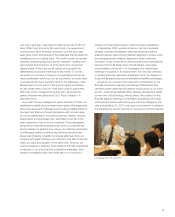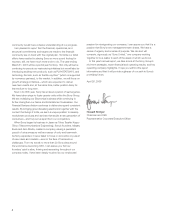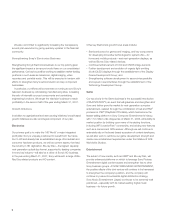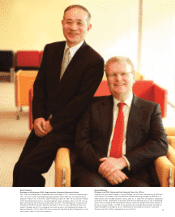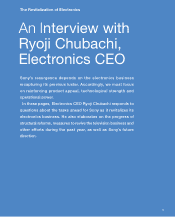Sony 2006 Annual Report Download - page 7
Download and view the complete annual report
Please find page 7 of the 2006 Sony annual report below. You can navigate through the pages in the report by either clicking on the pages listed below, or by using the keyword search tool below to find specific information within the annual report.5
Background
In June 2005, Sony formally established a new management
team led by Howard Stringer (Chairman and CEO) and
Ryoji Chubachi (President and Electronics CEO). Over its first 100
days, new management conducted an extensive business review,
which concluded that Sony maintained a strong and diversified
corporate portfolio but was facing certain market-based and
self-imposed structural challenges that were affecting the
company’s ability to compete effectively. New management
identified Sony’s key challenges as:
•Eliminating the “silo” organizational structure;
•Strategically focusing our overly broad range of product
offerings that dilute internal resources;
•Enhancing limited product interoperability;
•Strengthening software and service development; and
•Divesting non-strategic assets that divert management’s focus.
These findings led to the development of a comprehensive
revitalization plan that was publicly presented in both Tokyo and
New York in September 2005. This plan, developed in consultation
with Sony’s stakeholders both inside and outside the company,
moved to strengthen Sony’s competitiveness in three core
sectors—Electronics, Game and Entertainment—through a balanced
mix of restructuring and growth initiatives combined with a new
organizational structure. From a financial perspective, the plan
targeted a consolidated operating profit margin of five percent
(before restructuring and one-time charges) for the year ending
March 31, 2008.
The following is a summary of the key components of the
revitalization plan upon which Sony’s mid-term corporate strategy
is being executed.
Organizational Structure
While Sony experienced tremendous growth over the past 60
years, its organizational structure had become fragmented, with
limited integration and cooperation. Specifically, Sony suffered
from a layered and cumbersome decision-making structure that
led to inefficient resource allocation and significant redundancies.
In order to best execute our revitalization plan, fundamental
organizational changes were required. As such, we created a new,
more streamlined structure that abolished the “Network Company”
system within Electronics in favor of a more centralized Electronics
Business Group. As a result, key decision making and key functional
areas—such as product planning, technology, procurement,
manufacturing, and sales and marketing—have been consolidated
under the Electronics CEO. This significant structural change was
designed to eliminate the business “silos” that had prevented us
from focusing resources on our most competitive “champion”
products and to foster a more coordinated, efficient and rapid
decision-making process. In addition, the new structure would
enable us to prioritize R&D, and optimally maximize our resources
for growth.
Path to Profitability Restructuring Initiatives
In tandem with implementing a new organizational structure, we
committed to achieving:
•¥200.0 billion in cost reductions (80 percent to be achieved by
the year ending March 31, 2007; the remainder to be achieved
by the year ending March 31, 2008):
• 11 out of 65 manufacturing sites to be closed or consolidated;
• 20 percent reduction in product model count; and
• 10,000 person head-count reduction
•¥120.0 billion in proceeds from non-strategic asset sales (e.g.,
real estate and minority equity stakes).
Of the ¥200.0 billion in cost reductions, ¥130.0 billion would
come from streamlining business operations, reducing our product
model count, consolidating our manufacturing sites and enacting
action plans for 15 selected business categories. The additional
¥70.0 billion in cost reductions would be derived from organizational
structure changes resulting in reduced headquarters and indirect
overhead expenses.
Estimated charges for these structural reforms, originally
expected to be approximately ¥210.0 billion but since revised to
approximately ¥190.0 billion, are expected to be fully recouped by
the year ending March 31, 2009.
New Management’s Mid-Term Corporate Strategy





